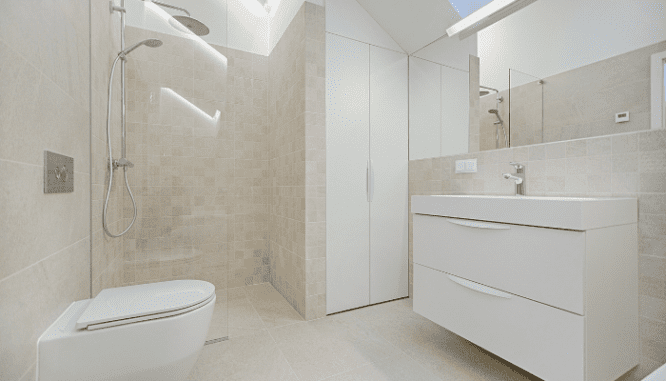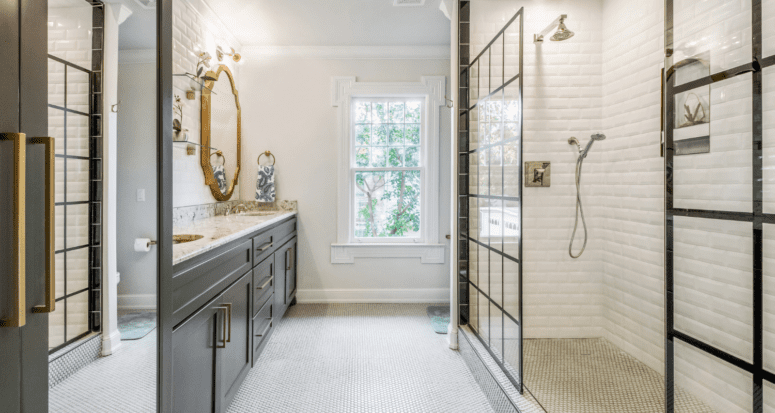Selling a House Without a Bathtub: Can You Get Away With Only Showers?
- Published on
- 2 min read
-
 Laura Leavitt Contributing AuthorClose
Laura Leavitt Contributing AuthorClose Laura Leavitt Contributing Author
Laura Leavitt Contributing AuthorLaura Leavitt is a freelance writer and editor who has written about real estate and home-related topics since 2017, in addition to writing about travel, small businesses, and sustainability topics. She owns her own 112-year-old home in Ohio.
It’s time to remodel the bathroom, and you’re contemplating a bold decision: to remove the last remaining bathtub of the house in favor of a spacious shower. Maybe the kids prefer to take showers now that they’re a little older, or you’d love to have a stall that’s easier to climb in and out of on a daily basis. In any case, you need to weigh these personal preferences versus some valid concerns about selling a house without a bathtub down the line.
What will this decision mean for resale — and will you wish you’d kept the home more broadly marketable? We dug into bathroom remodeling trends and spoke with real estate experts on how tub preferences have changed, the growing appeal of showers, and how much you can expect to limit your buyer pool with a tub-less house.

Bathtubs haven’t gone away, but trends have shifted
Bathtubs have long offered a mix of spa-like benefits in addition to their practical uses, like bathing your kid or cleaning your dog’s muddy paws. But homeowner preferences have certainly shifted over the years when it comes to bathtub styles. When the Jacuzzi brothers invented the first hydrotherapy jetted tub in 1956, it became a valued feature for many homes well into the ‘80s, and ‘90s.
However, most home design trends have a shelf-life, and jetted tubs were no exception. People soon came to realize that jets are a pain to clean, and large tubs require a ton of hot water to fill. Over time, many of these tubs became glorified storage bins.
Now, freestanding tubs are considered the “modern” option. Many of them come in beautiful designs, and these tub styles have a smaller footprint than their jetted predecessors.
“We do a lot of luxury real estate, and freestanding tubs are very common — new construction almost always has these contemporary-looking bathtubs that are longer and wider,” says Woody Fincham, an appraiser Charlottesville Virginia area and the recipient of the Outstanding Service Award at the 2017 International Valuation Conference.
However, recent remodeling research indicates that the importance of having any bathtub at all in the primary bathroom is dwindling. A study from Houzz found that in 2019, half of renovated main bathrooms had no bathtub, while the number of homeowners who say they enjoy soaking in the tub for relaxation dropped 7 percentage points to 55%.
While not having a tub in the main bathroom isn’t the same as having no tub in the house, it does indicate that shower versus bath preferences are becoming more fluid in American households, with upscale showers as an alternative gaining more ground.
Shower accessibility, relaxation will be on your side
For further insights on how hard it is to sell a house without a bathtub today, we turned to Robb Harrison, a top real estate agent in Ocala, FL. Harrison says that in his market, he has noticed a remodeling trend of homeowners installing showers rather than bathtubs. He doesn’t believe the decision does much to harm a home’s marketability. A home with fewer or no bathtubs can actually hold a certain appeal with the right buyer and demographics, he shares.
“Here in Florida, taking out a tub isn’t a bad thing — a lot of people are taking out tubs and putting in showers because they are a lot more accessible for people,” says Harrison, who works extensively with homes marketed to the age 55+ community.
In addition to the accessibility factor, data from Houzz shows that showers have secured equal footing with tubs in the relaxation department, with 54% of homeowners saying they enjoy long showers to wind down.

Certain homebuyers will still rule you out or be disappointed
Even if bathtubs have lost a bit of luster over the years, some buyers are more likely to consider a bathtub a key feature to the point where they might walk away if you don’t have one, including:
- Luxury home shoppers: If your home is only a few years old or is located in a higher-end community, the expectation is going to be that at least one bathroom has a tub, according to Fincham’s experience. Luxury homes often have enough bathrooms to offer space for a garden tub and one or more walk-in showers.
- First-time homebuyers: Many first-time homebuyers, whose average age is 33 years old, will require that whatever home they buy has a tub. Millennial homebuyers are currently most likely to have children in the home, according to the National Association of Realtors 2020 Generational Trends Report. If your neighborhood or market is likely to be popular among young families, removing a tub could have a bigger impact on your ability to sell.
- Lastly, among 55+ communities, anyone with grandchildren visiting and staying over may also put a bathtub on their must-have list.
It helps to highlight other desirable bathroom features
If you don’t keep the tub in your renovation, you can incorporate other modern design features to boost your home’s appeal for resale.
“Higher countertops and vanities are popular, and double sinks are desired in both the master and main bath,” says Harrison. “It’s better for storage, and it’s more comfortable, with better posture standing straighter at the vanity.”
HomeLight’s survey of over 1,000 real estate agents in Q4 2020 confirms that a double sink vanity ranks as the no. 1 desired bathroom upgrade in 2021 with 65% of agents saying this feature appeals to buyers. In addition, a rainshower head (39%) and dual shower heads (37%) are the second and third more desirable bathroom features, so make sure you don’t skimp on the fixtures when you install your new shower.
Other features that can attract buyers include artisan tile work, heated floors (especially in cold climates) and — Harrison adds — comfort height toilets.

Offering a tub credit can offset concerns
While not having a bathtub anywhere in a home is definitely outside the norm at this point, you need your house to serve your needs. If you expect to use your newly remodeled bathroom for years, you may get enough use out of a walk-in shower or other feature for it to be worth a price concession to your potential buyer to add the tub back in when that time comes.
If you intend to sell soon, however, consider this: Would you be willing to concede the cost of a tub addition (a reasonable, medium-level one can be installed for $1,500-$2,500) if a buyer demands one? Your answer should drive whether you take that last tub out or leave it in for a home that appeals to the broadest possible market of buyers.
Header Image Source: (C Woods Photography / Shutterstock)
